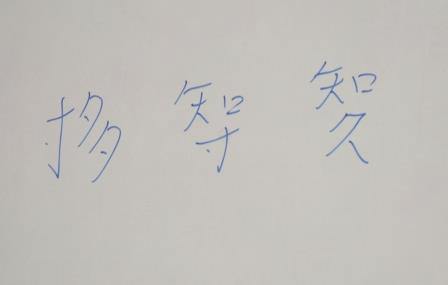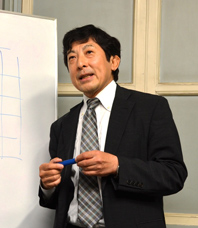Professor Kazusuke Tsujimura, Faculty of Economics, Understanding Economic Structure through Statistics
*Position titles, etc., are those at the time of publishing.
Kazusuke Tsujimura

Prof.Kazusuke Tsujimura graduated from Keio University’s Faculty of Business and Commerce in 1976, and completed his doctoral course requirements in 1981 at the Graduate School of Economics. He has a Ph.D. in Business and Commerce. He studied at St Antony’s College, University of Oxford, from 1982 to 1984. He became an assistant lecturer of the Faculty of Economics at Keio University in 1979 and later a professor in 1997. He specializes in economic statistics, econometrics, national accounting, and flow of funds analysis. He became a member of the Council for National Accounts Studies in 2004. His main English publications include “Balance Sheet Economics of the Subprime Mortgage Crisis” (2011, Economic Systems Research), “The Consequences of the Introduction of the Euro: A Nested Mixed-effects Analysis of the International Banking Positions” (2008, Empirical Economics), and “Asset-Liability-Matrix Analysis Derived from Flow-of-Funds Accounts: the Bank of Japan’s Quantitative Monetary Policy Examined” (2003, Economic Systems Research).
Seeing just the particulars or the whole picture changes our perspective on the economy

──Firstly, can you please explain to us what is involved in the study of economic statistics?
Economic statistics as a name of a field of study, which is a literal translation of the French word statistiques économiques, may be unfamiliar to English speakers. Econometrics is mainly about economic analysis based on probabilistic inference while economic statistics deals mainly in designing statistics: national accounts, census and survey, etc. Actually, Keio University has a significant history in the field of economic statistics since its founding. Economic statistics was first introduced to Japan in 1860 with the book Bankoku Seihyo, which was a translation of a Dutch book. It was Yukichi Fukuzawa, the founder of Keio, who arranged the translation, and the main translator was none other than the first president of Keio, Shukichi Okamoto (who later changed his name to Setsuzo Furukawa and to Masao Furukawa). Incidentally, the first Japanese statistical book was Nihon Seihyo published in 1872 by Koji Sugi, a scholar who had earlier taught at a school of Dutch studies in Tokyo (then known as Edo). Yukichi Fukuzawa took over Sugi’s position at the school, which in fact was the origin of Keio University. Sugi was the one who laid the foundation for today’s population census of Japan.
Economics statistics deals with various statistics including household surveys that investigate the income and expenditure of individual households; corporate statistics that look at the assets and earnings of companies; input-output tables that indicate inter-industry transactions of goods and services; and flow of funds accounts that deal with the lender-borrower and payer-payee relationship. My specialization is national accounts from which we can get an overall picture of the economic activity within a country. The Systems of National Accounts (SNA), which is a collaboration among international organizations, is the international standard for national accounts and is an important tool for comparing economic activities at the international level. Input-output tables as well as flow of funds accounts have a central place in the SNA.
GDP (Gross Domestic Product), which is a term often heard in the media, is one of the main indicators of national accounts and is a measure of ‘value added’ of all goods and services produced within a country. For instance, various raw materials are required to manufacture an automobile that is worth 20,000 dollars. If it costs 18,000 dollars to purchase those materials, the added value is the difference between the selling price and the cost of materials, which is 2,000 dollars. If Japan produces 9 million of the same automobile, the added value also increases by 9 million times. In this way, we can calculate the gross value added. In order to calculate the value added, from which GDP is measured, we use input-output tables (or supply and use tables). The tables include matrices of the flow of goods and services—which are categorized into around 500 groups—between industries, industries and households, governments, and also countries. Economic statistics research involves looking at where the data comes from and how they should be constructed and analyzed.

──So you are trying to get the overall picture of the economy by making effective use of numbers based on abundant statistical data.
Yes, that is correct, but strictly speaking we are constructing logical arguments using set theory, matrix algebra, and other mathematical tools. However, for a lot of cases, you only need to understand the structure of statistics to extract meaningful information without having to engage in complex analysis.
For example, if we look at Japan’s budget deficit, many people may think that there is too much wasteful spending, but this is not really the case if you look at the country as a whole. With various issues such as the declining birthrate and population aging, people in Japan are concerned for the future and tend to save rather than spend. Saving implies the action of temporarily lending money; therefore, saving requires the presence of a borrower. In this respect, with banks acting as mediators, the ideal situation for an economy to grow is if companies become the borrowers and use this funding for capital investment. However, a vicious spiral is taking place in Japan as households are reluctant to spend, and with sales taking a hit, companies are finding it difficult to invest. Much of the problem would be solved if foreign countries were willing to become borrowers, but as the size of Japan’s savings is unparalleled in the world, it is not easy to find borrowers. That is why the Japanese government has been issuing deficit-covering bonds in order to restore balance in the economy. The government may perhaps be squandering money, but the bigger issue is how we can solve the current situation in which companies are not able to invest while the consumers are saving.
These issues become apparent if you understand the SNA comprehensively, but we have a tendency to focus only on the particulars, arguing about issues like making budget cuts in the following year because the current year recorded too many losses, and I believe that we are not talking enough about how we can restore balance to stabilize the overall economy.
Even if there are good methods for analysis, you cannot analyze data without corresponding statistics.

──In regards to national accounting, what specifically are you researching?
Like GDP, an approach to national accounts that focuses on the production and consumption of goods and services is known as ‘product flow method,’ and this is currently the mainstream method within economic statistics. This is because the UN implemented the product flow method back in 1968, which is grounded on input-output tables, as the estimation basis of SNA, recognizing markets that are still in the process of development.
As opposed to this method, I am researching the funds-flow method, which focuses on the flow of funds within an economy. In order not to repeat the bitter experience of the Great Depression that was preceded by the collapse of the financial bubble of the 1920s, Morris Copeland, an American economist of the 1940s, urged a better understanding of the circulation of funds in the macroeconomy. He had in his mind the stock and real estate crash that happened during the time when the US economy was so powerful, resulting in the Great Depression of the 1930s.
In order to look at the economy in its entirety, it is essential to observe the flow of both products and funds. That is why the SNA adopts input-output tables as well as flow of funds accounts as its core. However, in comparison to Copeland’s approach, which was based on the payer-payee relationship, the SNA flow of funds accounts (also known as financial accounts) covers only the lender-borrower relationship that corresponds to financial transactions rather than the more general payer-payee relationship that includes both real and financial transactions. At present, based on Integrated Macroeconomic Accounts, the US version of the SNA, we are attempting to construct statistics that depicts flow of funds similar to those devised by Copeland. Through this approach, we are trying to analyze how funds flows impact the production and consumption of goods and services. We found that there was a conspicuous change in the U.S. flow-of-funds structure between 2008 and 2010 when the subprime mortgage crisis hit the economy; and the dominant factor was the shift in monetary policy.
──So this means that it is important to select or construct statistics that are appropriate to what you are trying to analyze.
Yes, that is quite right, and in order to do so, you need to know the thoughts behind how the statistics were created in the first place. For example, balance sheets are constructed based on the concept that if someone lends money, it means someone owes money. You cannot decide whether to base your asset value on the market or acquisition cost unless you know what you are trying to analyze. If you make a mistake here, you may overlook important details. When you decide on the purpose of your analysis, you will be able to know what kind of statistics is necessary.

For example, the Bank of Japan employed a series of quantitative easing schemes during the period between 2001 and 2006 in an attempt to change the size and composition of their balance sheet. However, there were no methods to analyze this process at the time. As I was researching this issue with my collaborator and wife, Masako Tsujimura, we realized that we may be able to employ analysis methods constructed by Nobel Prize winners R. Stone and L. R. Klein. Flow of funds accounts are basically balance sheets that show the assets owned and the liabilities owed by all the participants of the economy—households, non-financial corporations, financial institutions, governments, central bank, and the rest of the world. Stone and Klein introduced matrix operations and proposed unique ideas that converted these statements to matrices similar to input-output tables. We thought that we may be able to use these methods to analyze the impact of the quantitative easing policies of the Bank of Japan on the economy. In fact, there are many such brilliant methodologies and ideas out there, but most of them have not been used. This is because existing statistical materials have not corresponded effectively with the theories until now. Therefore, what we do is manipulate statistical materials to make them more usable.
I want my students to use statistics and also to construct statistics

──In recent years, what are your students most interested in?
Lately it seems to me that as a general trend, Japanese university students have a stronger awareness of crisis. Since the 1990s, I have taught classes on Japan’s fiscal deficit and the necessity of capital investment to strengthen Japan’s international competitiveness, but in recent years I have noticed that students react more intensely to these topics. This is proof that they are aware Japan is facing a crisis, and it is also the first step toward improving the economy. We cannot make improvements unless we realize there are problems. In this respect, I find teaching very enjoyable and worthwhile.
If you are studying economic statistics at Keio, I hope it will enable you to gain an overall perspective of statistics. If you can grasp the bigger picture, you can get a bird’s-eye view of not only Japan’s, but also the world’s economic issues. Of course, this is also essential when you are constructing your own statistics. Even when you are selecting and employing existing statistics, you need to be able to create statistics that correspond to what you are trying to analyze and to be able to process it. In line with the founding principles of Keio University, I hope my students can make use of economic statistics to make our society a better place.
*This article appeared in "Kenkyu Saizensen" (July 22, 2015) of Keio University Japanese Website.
*Position titles, etc., are those at the time of the interview.
